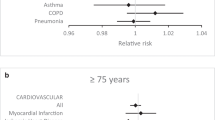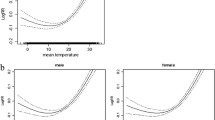Abstract
Global climate changes affect health and present new challenges to healthcare systems. The aim of the present study was to analyze the pattern of visits to the medical wing of emergency rooms (ERs) in public hospitals during warm seasons, and to develop a predictive model that will forecast the number of visits to ERs 2 days ahead. Data on daily visits to the ERs of the four largest medical centers in the Tel-Aviv metropolitan area during the warm months of the year (April–October, 2001–2004), the corresponding daily meteorological data, daily electrical power consumption (a surrogate marker for air-conditioning), air-pollution parameters, and calendar information were obtained and used in the analyses. The predictive model employed a time series analysis with transitional Poisson regression. The concise multivariable model was highly accurate (r 2 = 0.819). The contribution of mean daily temperature was small but significant: an increase of 1°C in ambient temperature was associated with a 1.47% increase in the number of ER visits (P < 0.001). An increase in electrical power consumption significantly attenuated the effect of weather conditions on ER visits by 4% per 1,000 MWh (P < 0.001). Higher daily mean SO2 concentrations were associated with a greater number of ER visits (1% per 1 ppb increment; P = 0.017). Calendar data were the main predictors of ER visits (r 2 = 0.794). The predictive model was highly accurate in forecasting the number of visits to ERs 2 days ahead. The marginal effect of temperature on the number of ER visits can be attributed to behavioral adaptations, including the use of air-conditioning.

Similar content being viewed by others
References
Baccini M, Biggeri A, Accetta G, Kosatsky T, Katsouyanni K, Analitis A, Anderson HR, Bisanti L, D'Ippoliti D, Danova J, Forsberg B, Medina S, Paldy A, Rabczenko D, Schindler C, Michelozzi P (2008) Heat effects on mortality in 15 European Cities. Epidemiology 19:711–719
Basu R, Samet JM (2002) Relationship between elevated ambient temperature and mortality: a review of the epidemiologic evidence. Epidemiol Rev 24:190–202
Bernard SM, Samet JM, Grambsch A, Ebi KL, Romieu I (2001) The potential impacts of climate variability and change on air pollution-related health effects in the United States. Environ Health Perspect 109[Suppl 2]:199–209
Bouchama A, Dehbi M, Mohamed G, Matthies F, Shoukri M, Menne B (2007) Prognostic factors in heat wave-related deaths. Arch Intern Med 167:2170–2176
Brumback BA, Ryan LM, Schwartz J, Neas L, Stark P, Burge H (2000) Transitional regression models, with application to environmental time series. J Am Stat Assoc 95:16–27
Central Bureau of Statistics (2009) Ownership of durable goods in deciles of household (Table 10). June 7, 2009. http://www.cbs.gov.il/publications09/1363/excel/t10.xls. Accessed 25 May 2010
Clarke JF (1972) Some effects of the urban structure on heat mortality. Environ Res 5:93–104
Davido A, Patzak A, Dart T, Sadier MP, Méraud P, Masmoudi R, Sembach N, Cao TH (2006) Risk factors for heat related death during the August 2003 heat wave in Paris, France, in patients evaluated at the emergency department of the Hôpital Européen Georges Pompidou. Emerg Med J 23:515–518
Ellis FP, Prince HP, Lovatt G, Whittington RM (1980) Mortality and morbidity in Brimingham during the 1976 heatwave. Q J Med 49:1–8
Empereur-Bissonnet P, Salines G, Bérat B et al. (2006) Heatwave in France, July 2006: 112 excess deaths so far attributed to the heat. Euro Surveill 11:E060803.3
Fischer PH, Brunekreef B, Lebret E (2004) Air pollution related deaths during the 2003 heat wave in the Netherlands. Atmos Environ 38:1083–1085
Fokianos K, Kedem B (2004) Partial likelihood inference for time series following generalized linear models. J Time Ser Anal 25:173–197
Gaffen DJ, Ross RJ (1998) Increased summertime heat stress in the US. Nature 396:529–530
Intergovernmental Panel on climate change (IPCC) (2007) Climate Change 2007: Synthesis Report; 4th Assessment Report (AR4). WMO, Geneva, Switzerland. http://www.ipcc.ch/publications_and_data/publications_ipcc_fourth_assessment_report_synthesis_report.htm. Accessed 15 Sep. 2010
Ishigami A, Hajat S, Kovats RS, Bisanti L, Rognoni M, Russo A, Paldy A (2008) An ecological time-series study of heat-related mortality in theree European cities. Environ Health 7:5–11
Johnson H, Kovats RS, McGregor G, Stedman J, Gibbs M, Walton H, Cook L, Black E (2005) The impact of the 2003 heat wave on mortality and hospital admissions in England. Health Stat Q 25:6–11
Jones TS, Liang AP, Kilbourne EM, Griffin MR, Patriarca PA, Wassilak SG, Mullan RJ, Herrick RF, Donnell HD Jr, Choi K, Thacker SB (1982) Morbidity and mortality associated with the July 1980 heat wave in St. Louis and Kansas City, MO. JAMA 247:3327–3331
Katsouyanni K, Pantazopoulou A, Touloumi G, Tselepidaki I, Moustris K, Asimakopoulos D, Poulopoulou G, Trichopoulos D (1993) Evidence of interaction between air pollution and high temperature in the causation of excess mortality. Arch Environ Health 48:235–242
Kenney WL (1997) Thermoregulation at rest and during exercise in healthy older adults. Exerc Sport Sci Rev 25:41–76
Kilbourne EM, Choi K, Jones TS, Thacker SB (1982) Risk factors for heatstroke. A case control study. JAMA 247:3332–3336
Kinney PL, O'Neill MS, Bell ML, Schwartz J (2008) Approaches for estimating effects of climate change on heat-related deaths: challenges and opportunities. Environ Sci Policy 11:87–96
Knowlton K, Rotkin-Ellman M, King G, Margolis HG, Smith D, Solomon G, Trent R, English P (2009) The 2006 California heat wave: impacts on hospitalizations and emergency department visits. Environ Health Perspect 117:61–67
Kovats RS, Hajat S (2008) Heat stress and public health: a critical review. Annu Rev Public Health 29:41–55
Kovats RS, Hajat S, Wilkinson P (2004) Contrasting patterns of mortality and hospital admissions during hot weather and heat waves in Greater London, UK. Occup Environ Med 61:893–898
Luber G, Prudent N (2009) Climate change and human health. Trans Am Clin Climatol Assoc 120:113–117
O'Neill MS (2003) Air conditioning and heat related health effects. Appl Environ Sci Public Health 1:9–12
Semenza JC, Rubin CH, Falter KH, Selanikio JD, Flanders WD, Howe HL, Wilhelm JL (1996) Heat-related deaths during the July 1995 heat wave in Chicago. N Engl J Med 335:84–90
Semenza JC, McCullough JE, Flanders WD, McGeehin MA, Lumpkin JR (1999) Excess hospital admissions during the July 1995 heat wave in Chicago. Am J Prev Med 16:269–277
Stedman JR (2004) The predicted number of air pollution related deaths in the UK during the August 2003 heat wave. Atmos Environ 38:1087–1090
Vanhems P, Gambotti L, Fabry J (2003) Excess rate of in-hospital death in Lyons, France, during the August 2003 heat-wave. N Engl J Med 349:2077–2078
Yannas S (2001) Towards more sustainable cities. Sol Energy 70:281–294
Acknowledgments
We thank the emergency room directors: Dr. Pinchas Halperin, Tel-Aviv Sourasky Medical Center, and Dr. Zvi Rottenberg, Rabin Medical Center; and Prof. Zeev Rotstein, director of the Sheba Medical Center, and Dr Itzhak Berlowitz, director of Wolfson Medical Center, for provision of healthcare utilization data.
Author information
Authors and Affiliations
Corresponding author
Rights and permissions
About this article
Cite this article
Novikov, I., Kalter-Leibovici, O., Chetrit, A. et al. Weather conditions and visits to the medical wing of emergency rooms in a metropolitan area during the warm season in Israel: a predictive model. Int J Biometeorol 56, 121–127 (2012). https://doi.org/10.1007/s00484-011-0403-z
Received:
Revised:
Accepted:
Published:
Issue Date:
DOI: https://doi.org/10.1007/s00484-011-0403-z




